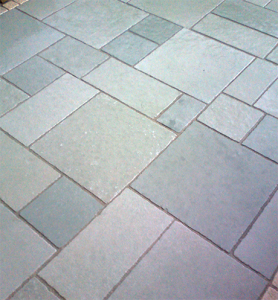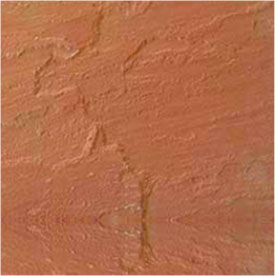Limestone Flooring – An Ultimate Natural Stone Delivering Impeccable Performance
July 5, 2023 AdminLimestone is one of the most widely utilized natural construction materials in the world because it is abundantly accessible and quite simple to shape or cut. Mainly used in the form of limestone tiles, this natural stone is a go-to flooring material for both residential and commercial projects worldwide. However, how is this common rock mined, processed, and utilized in goods like resilient flooring? This post will help you learn more about this well-liked material by examining its background, functions, and usage in resilient flooring. Additionally, you’ll discover the advantages of life cycle cost analysis of limestone flooring as a building material in a post-COVID environment.

Limestone- History and Formation

Nearly 15% of the sedimentary crust of the Earth is made up of the sedimentary rock limestone. The mineral calcite (calcium carbonate, CaCO3) makes up the majority of limestone, approximately 95% of it. Limestone contains calcite, which is created by marine species that secrete shells or whose coral reef-building calcium carbonate skeletons.
When an organism dies, its shell and bones are broken down by the waves and land on the ocean floor where they are compacted over millions of years and become limestone under the pressure of the ocean. Although limestone is a naturally occurring substance, it is regarded as a non-renewable resource since it takes far longer to develop than it does for humans to use it.
Generally speaking, shallow, calm, and warm sea waters are where limestone occurs. Between 30 degrees North Latitude and 30 degrees South Latitude on the globe, limestone accumulations may be found. These deposits may be found in the Gulf of Mexico, the Persian Gulf, the Indian Ocean, and the Caribbean Sea.
In caverns where water seeps through the floor, limestone also develops by evaporation. The calcium carbonate dissolves and deposits itself on the cave’s wall and ceiling. The size of these deposits increases over time, and they can extend into the cave’s deepest chambers.
Characteristics of Limestone
Depending on its mineral makeup and physical makeup, limestone may be found in a wide range of types with a variety of textures and porosities. It’s white or almost white when made only of calcium carbonate. Magnesium, iron, or manganese may also be present in limestone, all of which will alter how white it is. Chert, clay, flint, sand, organic residue, and iron oxide all contribute to the creation of other colours including grey, yellow, and brown. Scratching is simple on limestone. It is a soft rock with a density of 2.5 to 2.7 grammes per cubic centimetre and a hardness of 3 to 4 Mohs.

A kind of limestone called travertine is created by mineral deposits around waterfalls, hot or cold springs, and along streams. Rapid precipitation of calcite results in the formation of this sedimentary stone. Calcite and other minerals combine to produce remarkable swirls and movement that give travertine its distinguishing appearance.
Limestone that is soft, white, and porous is called chalk. Over millions of years, the calcite mineral remnants of microorganisms gradually build up to become chalk in shallow seas. Chalk has been mined since prehistoric times and serves as both a construction material and a field soil conditioner.
Mining and Extraction

Depending on the rock’s hardness, limestone is removed from quarries and underground mines by mechanical excavation or blasting.
Limestone is taken from the Earth’s surface when it is mined from a quarry, commonly known as open pit mining or surface mining. The overburden (the material underneath the top soil that covers the mineral) is removed after the top soil has been removed. In order to shatter the rocks, drilling is used. Explosives are used to remove large boulders that are difficult to drill through in order to get at the limestone.
Additionally, limestone may be mined underground. When limestone is found more than 100 metres below the surface or when the topsoil surrounding the material is extremely hard, underground mining is used. Horizontal drills result in substantially smaller blast holes than open pit mining. Each time explosives are sent down the holes, a significant amount of rock is produced. After blasting, scaling rig equipment is used to remove the loose rocks from the mine.
Crushing, Screening, and Grinding
One of the most accessible and useful rocks for a variety of applications is limestone. By separating the rock in quarry ledges and splitting it into blocks, slab extraction is accomplished. The majority of mined limestone is converted into aggregate. Crushed limestone, pulverised limestone, concentrated calcite, and lime (quicklime and slaked lime) may all be produced from limestone.
After being mined or extracted from a quarry, limestone is trucked to a processing facility where it is put into a bin for coarse crushing. For preliminary size reduction, crushers are employed. The big rock and smaller stone are separated from one other by a vibrating, inclined screen that receives the crushed stone bits. The secondary crusher, which normally reduces material to a size of between 1 and 4 inches, processes the stone that is too big to pass through the top deck of the screen.
Because it is sufficiently tiny for the final crushing stage, the material from the second level of the screen (also known as “throughs”) skips the secondary crusher. The tertiary circuit, which consists of a sizing screen and a tertiary crusher, receives the output from the secondary crusher and the “throughs” from the secondary screen via conveyor.
Sustainability
The limestone obtained from local limestone suppliers was a common choice even before COVID supply chain problems. Reducing transportation is ecologically friendly, and it frequently results in cost savings because of the decline in transportation expenses. Additionally, more and more architects and designers are using materials that are created in accordance with various green building standards as well as LEED criteria set by the US Green Building Council (USGBC).
Locally sourced stone is described as having been quarried or harvested within 500 miles of the construction site under USGBC regulations. Many natural stone quarries provide consumers with a large selection of locally sourced stone, including limestone.

For sites where limestone is processed, the natural stone sector is simultaneously working towards more sustainable environmental, social, and human health practises. The National Stone Council developed the ANSI/NSC 373 Standard to acknowledge sustainable environmental, social, and human health practises in the natural stone sector. To safeguard nearby watersheds and the ecology, recommendations include improving storm water containment and management systems, reducing energy usage, and turning otherwise useless stone into various grades of crushed stone.
Limestone in The World of Architecture

One of the most widely utilised natural rocks on the globe is limestone. It is easily accessible and may be carved intricately or sliced into chunks. Cement, mortar, quicklime (calcium oxide), and slaked lime (calcium hydroxide) are all products made from limestone. Limestone that has been crushed is excellent for building sturdy road foundations.
Calcium carbonate in limestone is converted to calcium oxide when it is heated to a high temperature, which produces lime. Lime is a mineral filler and an anti-stripping component used in hot-mix asphalt. Adding hydrated lime to hot-mix asphalt can extend a highway’s lifespan by several years. Limestone that has been ground up is used as a soil conditioner to balance acidic soil conditions.
Limestone is used for worktops and flooring in residential areas. Additionally, it is crushed and screened to extract cement and other building materials. The current applications for limestone are almost limitless, including the production of concrete, railroad ballast, road foundation, pipe bedding, under slab filler, flux stone, and agricultural lime.
Limestone aids in making liquid glass simpler to handle and mold into the desired shape during the glassmaking process. Limestone also aids in preventing devitrification, a crystallization process that occurs around minute impurities in the mixture and results in clouding and other flaws.
Limestone contains calcium carbonate, which is used as an antacid and nutritional supplement. Calcium carbonate serves as an anti-caking agent, an additional source of calcium, and a white food color when used as a food additive.
Types of Resilient Flooring Made Using Limestone
Today, resilient flooring is a well-liked option for both commercial and residential settings, and it is best for locations with a lot of activity. Although there are specialized types of resilient flooring, such as cork or vinyl-free flooring, it is typically considered to be hard flooring that nevertheless has some “give” and flex. Resilient flooring is available in sheets, planks, and tiles. Resilient sheet and tile flooring is offered in commercial grade and household grade, like many other building materials. The thickness of residential vinyl flooring varies. Commercial flooring choices including limestone flooring complies with requirements for improved stain resistance and durability. For high-traffic public spaces, some commercial-grade vinyl floorcovering includes extra non-slip features.
Solid Polymer Core (SPC) Vinyl Plank Flooring
SPC vinyl flooring, which stands for both solid polymer core and stone plastic composite, frequently mimics the appearance of real wood or stone with a conventional PVC top or wear layer. SPC is a product of engineering that combines stabilizers, PVC plastic, and limestone to create a hard and long-lasting mostly PVC product. The most common type of SPC is frequently known as “click-float flooring,” which alludes to the stiff planks/tiles “floating” over the subfloor without the need for glue by clicking together. This indicates that the subfloor does not need to be completely prepared or totally smooth.
Luxury Vinyl Tile (LVT) Flooring
Similar to SPC is luxury vinyl tile (LVT) flooring. Both are made up of a waterproof, indent-resistant PVC/limestone core, a decorative/image layer, a wear layer that is strong and scratch-resistant PVC, and a backing layer. LVT is flexible and typically 3.2 mm in gauge or thinner, whereas SPC is stiff and typically 3.5 mm in gauge or thicker to enable the tongue and groove click install. LVT is sometimes referred to in the industry as “dry back” flooring since it is virtually always attached to a properly prepared subfloor without clicking together.
Luxury Vinyl Sheet Flooring
In a number of market sectors, including healthcare and assisted living, corporate/workplace, schools, multifamily housing, restaurants, grocery shops, and other retail spaces, luxury vinyl sheet flooring has been around for decades and is still a popular flooring option.
There is some limestone in luxury vinyl sheet flooring, but not as much as in SPC or LVT. Ink and an engraved cylinder are used in the “rotogravure” printing technique, which is used to create this flooring, to imprint a pattern on the surface. Although perimeter (glue just the exterior borders) and loose lay (no glue) installations are also feasible with some types of sheet vinyl, they are less common.
Vinyl Composition Tile (VCT) Flooring
Vinyl composition tile (VCT) is a type of flooring largely utilized in commercial, institutional, and educational settings. More than 65% of VCT is made up of limestone and PVC. VCT is employed in high-traffic commercial applications such as retail stores, public buildings, schools, and massive office complexes because it is strong and affordable.
Benefits of Limestone Flooring
A naturally occurring substance called limestone improves every product to which it contributes. Because it takes far longer for limestone to produce than it does for humans to use it, it is a non-renewable resource. Limestone flooring is still abundantly accessible right now in every country in the world. There are options to buy domestically derived limestone almost wherever on earth. As new procedures for developing ecologically friendly specialty goods are introduced, this is excellent news for resilient flooring producers that want to raise the percentage of limestone in their products.
The Conclusion
With numerous limestone suppliers available all across the world, it is no big thing to get high-quality limestone for flooring projects. Regatta Universal Exports is one of the top-rated limestone manufacturers, exporters, and suppliers in India and provide best quality natural stones at factory rates.








